Box joined shelf brackets

After I built my fancy box joint jig,
I was keen to find more uses for it. I was running out of room on my
lumber rack so I decided to make some
shelving brackets to hold some lumber on the wall opposite to it near
the ceiling.
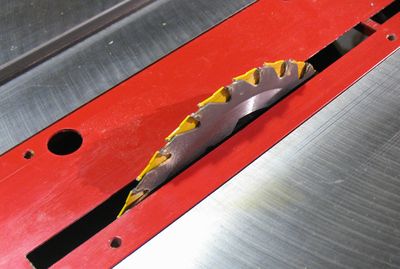 I wanted the individual fingers to be approximately 4 mm thick. This is thicker
than a saw blade, but still thinner than what can be done with a dado set.
Combining a thin kerf 7 1/4" blade and a regular kerf 7 1/4" blade produced
about the right thickness. With a 0.2 mm spacer between the blades, it turned out
to be just the right thickness to work with two turns worth of advance on
the 42 tooth gear against the 16 tooth gear on my fancy
geared box joint jig.
I was lucky that the two blades had exactly the same diameter. 7 1/4" blades
are often a bit larger or smaller than nominal, so not just any pair of blades
can be combined like that.
I wanted the individual fingers to be approximately 4 mm thick. This is thicker
than a saw blade, but still thinner than what can be done with a dado set.
Combining a thin kerf 7 1/4" blade and a regular kerf 7 1/4" blade produced
about the right thickness. With a 0.2 mm spacer between the blades, it turned out
to be just the right thickness to work with two turns worth of advance on
the 42 tooth gear against the 16 tooth gear on my fancy
geared box joint jig.
I was lucky that the two blades had exactly the same diameter. 7 1/4" blades
are often a bit larger or smaller than nominal, so not just any pair of blades
can be combined like that.
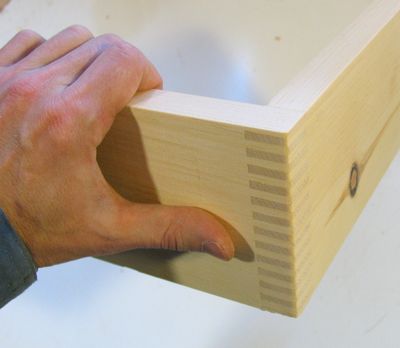 I made several L shaped box joined parts out of boards, one of which is shown at left.
I then ripped the width of the brackets
out of them afterwards. The piece at left was enough for two brackets.
I made several L shaped box joined parts out of boards, one of which is shown at left.
I then ripped the width of the brackets
out of them afterwards. The piece at left was enough for two brackets.
 The only thing that holds the brackets up is the strength of the box joint.
Partly this is a bit of a test of the strength of a box joint. If I wasn't keen
on at the same time putting the joints to the test, I might have added some
sort of diagonal splines to the brackets, or used thicker material.
The only thing that holds the brackets up is the strength of the box joint.
Partly this is a bit of a test of the strength of a box joint. If I wasn't keen
on at the same time putting the joints to the test, I might have added some
sort of diagonal splines to the brackets, or used thicker material.
Or maybe I just made them that way because I can! :)
I loaded them up with the heaviest pieces of hardwood that I have. I don't dig
through those pieces as often, so it's ok to have them in a relatively awkward
spot. They are about 182 cm (6'1") off the floor - high enough for most people
not to bang their head against them. And the door frames
in my basement are lower at any rate.
 I wanted the individual fingers to be approximately 4 mm thick. This is thicker
than a saw blade, but still thinner than what can be done with a dado set.
Combining a thin kerf 7 1/4" blade and a regular kerf 7 1/4" blade produced
about the right thickness. With a 0.2 mm spacer between the blades, it turned out
to be just the right thickness to work with two turns worth of advance on
the 42 tooth gear against the 16 tooth gear on my fancy
geared box joint jig.
I was lucky that the two blades had exactly the same diameter. 7 1/4" blades
are often a bit larger or smaller than nominal, so not just any pair of blades
can be combined like that.
I wanted the individual fingers to be approximately 4 mm thick. This is thicker
than a saw blade, but still thinner than what can be done with a dado set.
Combining a thin kerf 7 1/4" blade and a regular kerf 7 1/4" blade produced
about the right thickness. With a 0.2 mm spacer between the blades, it turned out
to be just the right thickness to work with two turns worth of advance on
the 42 tooth gear against the 16 tooth gear on my fancy
geared box joint jig.
I was lucky that the two blades had exactly the same diameter. 7 1/4" blades
are often a bit larger or smaller than nominal, so not just any pair of blades
can be combined like that.

 I made several L shaped box joined parts out of boards, one of which is shown at left.
I then ripped the width of the brackets
out of them afterwards. The piece at left was enough for two brackets.
I made several L shaped box joined parts out of boards, one of which is shown at left.
I then ripped the width of the brackets
out of them afterwards. The piece at left was enough for two brackets.
 The only thing that holds the brackets up is the strength of the box joint.
Partly this is a bit of a test of the strength of a box joint. If I wasn't keen
on at the same time putting the joints to the test, I might have added some
sort of diagonal splines to the brackets, or used thicker material.
The only thing that holds the brackets up is the strength of the box joint.
Partly this is a bit of a test of the strength of a box joint. If I wasn't keen
on at the same time putting the joints to the test, I might have added some
sort of diagonal splines to the brackets, or used thicker material.
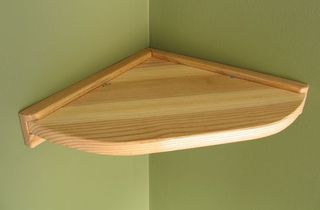 Building a corner shelf
Building a corner shelf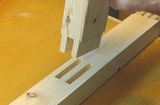 Double tenoned shelf supports
Double tenoned shelf supports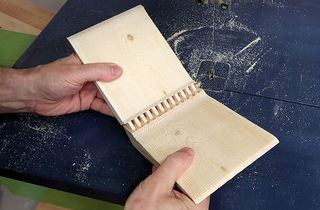 Making shelf brackets
Making shelf brackets